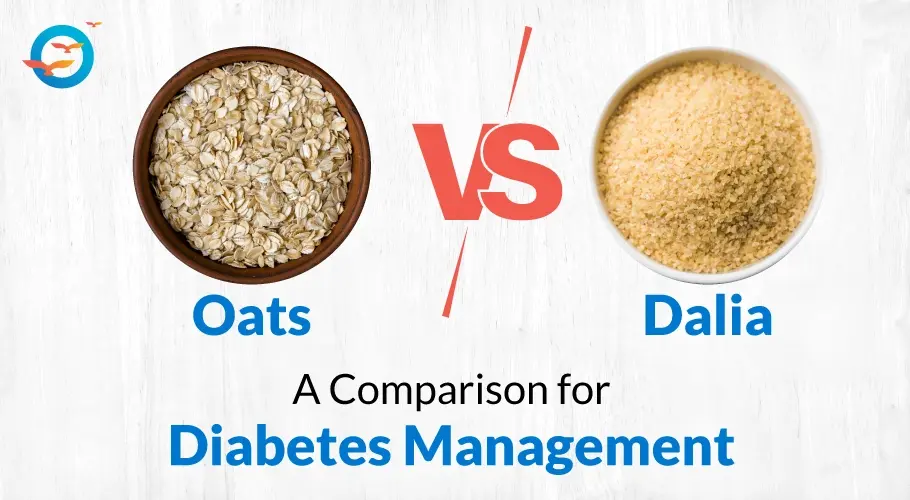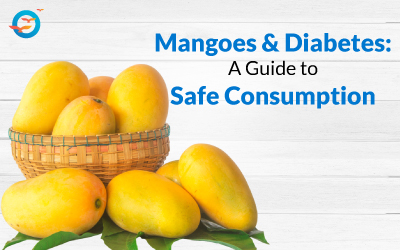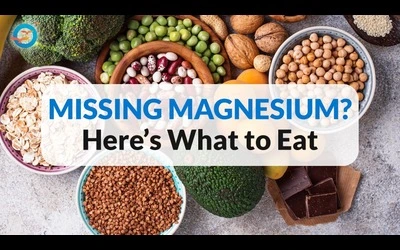Oats vs Dalia: Which is Better for Diabetes?

How Do Oats and Dalia Impact Blood Sugar Levels?
When managing diabetes, diet plays a crucial role. Two popular breakfast options that often come under scrutiny are oats and dalia (broken wheat).
Both are nutritious, but which one is better for diabetes? Let's delve into their benefits and drawbacks to help you make an informed decision.
Nutritional Profiles
Oats:
-
High in Fiber:
Oats are renowned for their high fiber content, particularly beta-glucan, which helps regulate blood sugar levels and improves insulin sensitivity. -
Low Glycemic Index:
Oats have a low glycemic index (GI) of around 55, meaning they cause a slower rise in blood sugar levels. -
Rich in Nutrients:
Oats are packed with vitamins, minerals, and antioxidants, including manganese, phosphorus, magnesium, copper, iron, zinc, folate, and vitamins B1 and B5.
Dalia (Broken Wheat):
- High in Fiber:
Dalia is also high in dietary fiber, which aids in controlling blood sugar levels and supports digestive health. - Low Glycemic Index:
With a GI of about 41, dalia is an excellent choice for maintaining stable blood sugar levels. - Nutrient-Rich:
Dalia provides essential nutrients such as magnesium, phosphorus, iron, and B vitamins, which are vital for overall health.
Health Benefits for Diabetes
Oats Benefits for diabetes
Blood Sugar Control:
The soluble fiber in oats slows down the absorption of glucose, helping to prevent spikes in blood sugar levels.Heart Health:
Oats can lower cholesterol levels, which is beneficial for individuals with diabetes who are at higher risk for heart disease.Weight Management:
Oats can promote satiety and help manage weight, an important aspect of diabetes management.
Benefits of Dalia
-
Blood Sugar Regulation:
The complex carbohydrates and fiber in dalia slow down the digestion process, ensuring a gradual release of glucose into the bloodstream. -
Digestive Health:
Dalia supports digestive health by promoting regular bowel movements and preventing constipation, common issues in diabetes. -
Sustained Energy:
Dalia provides a steady source of energy, which is beneficial for maintaining consistent blood sugar levels throughout the day.
Practical Considerations
Preparation and Taste:
1. Oats for diabetes
Oats are quick to prepare and versatile. They can be made into porridge, smoothies, and even savory dishes. Their mild flavor makes them adaptable to various recipes.
Types of oats
1. Whole Oat Groats
These are the most intact and unprocessed form of oats. The inedible outer husk is removed, leaving the whole grain.
- Cooking Time: Longest of all oat types, typically 45-60 minutes.
- Uses: Ideal for hearty dishes like oat groat salads or pilafs.
2. Steel-Cut Oats (Irish Oats)
Whole oat groats chopped into two or three pieces using steel blades.
- Texture: Chewy and nutty.
- Cooking Time: Around 20-30 minutes.
- Uses: Perfect for a robust and textured porridge.
3. Scottish Oats
Stone-ground oat groats, resulting in a finer texture than steel-cut oats.
- Texture: Creamier and smoother than steel-cut oats.
- Cooking Time: 10-20 minutes.
- Uses: Great for a creamy, porridge-like consistency.
4. Rolled Oats (Old-Fashioned Oats)
Steamed oat groats rolled into flat flakes.
- Texture: Softer and quicker to cook.
- Cooking Time: About 5-10 minutes.
- Uses: Versatile for oatmeal, baking, granola, and cookies.
5. Quick Oats (Instant Oats)
Rolled oats that are steamed longer and rolled thinner than old-fashioned oats.
- Texture: Very soft and quick to cook.
- Cooking Time: 1-5 minutes.
- Uses: Ideal for quick breakfasts, smoothies, and baking.
6. Instant Oats
The most processed form, pre-cooked, dried, and often flavored or sweetened.
- Texture: Extremely soft and mushy.
- Cooking Time: Instant; just add hot water or microwave for 1-2 minutes.
- Uses: Convenient for quick meals, though often higher in sugar and additives.
7. Oat Flour
Finely ground oats, typically from rolled oats.
- Uses: Used in baking for a mild oat flavor and added nutritional value in pancakes, muffins, and bread.
8. Oat Bran
The outer layer of the oat groat, rich in fiber.
- Uses: Added to cereals, smoothies, and baked goods for a fiber boost.
2. Dalia: Is Dalia Good for Diabetes?
Dalia takes slightly longer to cook but is equally versatile. It can be prepared as a sweet or savory dish, making it a great addition to both breakfast and main meals.
Types of Dalia
1. Wheat Dalia
Made from whole wheat kernels that are cleaned, husked, and processed into small, coarse granules.
Nutrition:
- High in fiber
- Protein
- Vitamins
- Minerals
Uses:
Commonly used in Indian cuisine for dishes like sweet dalia, upma, khichdi, and savory porridge. It can also be used as a rice substitute.
2. Barley Dalia
Produced from whole barley grains that are hulled and broken into smaller pieces.
Nutrition:
- Rich in fiber
- Especially beta-glucan, which helps in reducing cholesterol levels.
- It is also high in vitamins and minerals.
Uses:
- Used in soups, stews, salads, and as a base for porridge.
- It has a chewy texture and nutty flavor.
3. Maize Dalia (Cornmeal)
Made from dried corn kernels that are ground into a coarse meal.
Nutrition:
- Carbohydrates
- Fiber
- Vitamin A and B-complex vitamins
Uses:
- Commonly used in dishes like polenta, porridge, and as a coating for fried foods.
- It can also be used in baking.
4. Rice Dalia
Made from broken rice grains that are milled and processed.
Nutrition:
- Provides a good source of carbohydrates
- Enriched with vitamins and minerals.
Uses:
- Ideal for making rice porridge, soups, and rice-based dishes.
- It is easy to digest and often used in baby food and convalescent diets.
5. Oats Dalia
Produced from whole oat groats that are cut or rolled into smaller pieces.
Nutrition:
- High in fiber, particularly beta-glucan, which helps maintain cholesterol levels and promotes heart health.
Uses:
- Perfect for making oatmeal, porridge, and as an addition to baked goods for extra texture and nutrition.
Availability and Cost:
Oats: Widely available and generally affordable, oats can be found in most grocery stores.
Dalia: Dalia is also commonly available, especially in regions where wheat is a staple. It is usually inexpensive and accessible.
Which is Better for diabetes?
Both oats and dalia offer significant health benefits for individuals with diabetes. The choice between the two depends on personal preference, dietary needs, and how your body responds to each.
If you prefer a quick, versatile option:
Oats may be the better choice due to their ease of preparation and adaptability in various dishes.
If you enjoy a heartier, more traditional meal:
Dalia could be more suitable, offering sustained energy and a rich nutrient profile.
Ultimately, incorporating either oats or dalia into a balanced diet can support diabetes management. Experiment with both to see which one fits best with your lifestyle and taste preferences. Always consult with a healthcare professional or a dietitian to tailor your diet to your specific needs.
By choosing nutrient-dense foods like oats and dalia, you're taking a positive step towards better diabetes management and overall health.
FFD special advice
- Oats: We advise individuals with diabetes and those mindful of their health to choose steel cut rolled oats as they are better than the processed rolled oats.
- Enhancing the nutritional value of meals by incorporating various food groups is highly beneficial. You can include dals/legumes for protein, nuts for healthy fats, and vegetables for fiber, vitamins, and minerals. While choosing cereals one should prefer least processed cereal over highly processed ones.
- Ultimately, both oats and dalia are grains with similar nutritional profiles. Including both in a balanced diet can help individuals reap the benefits of each.
Eat healthy, live healthy!
Read more about Is Wheat Chapati Good for Diabetes? Visit our blog.
FAQs
How do oats help in managing blood sugar levels?
Oats contain soluble fiber, especially beta-glucan, which helps slow the absorption of sugar into the bloodstream, making them beneficial for blood sugar regulation.
Is dalia good for diabetes?
Yes, dalia (cracked wheat) is a healthy grain for diabetics as it’s high in fiber, low in fat, and helps in managing blood sugar levels when eaten in moderation.
What is the glycemic index of oats vs dalia?
Oats typically have a lower glycemic index (GI) compared to dalia, meaning they have less impact on blood sugar levels, making oats a better option for diabetics.
Can oats help with weight loss in diabetes?
Yes, oats can help with weight loss as they are high in fiber, which keeps you full longer, and may aid in controlling blood sugar levels and reducing fat accumulation.
Which grain is better for a diabetic breakfast: oats or dalia?
Oats are often considered the better option for breakfast for diabetics due to their high fiber content and ability to stabilize blood sugar levels.
Can I eat oats and dalia together if I have diabetes?
Yes, combining oats and dalia in a meal can provide a variety of nutrients and fiber, but it's important to monitor portion sizes to avoid blood sugar spikes.

